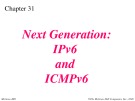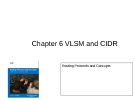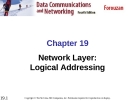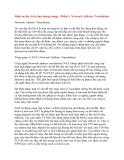
Addressing the network –ipv4
-
Chapter 4: Network layer. Introduction, network layer overview, IPv4 address, IPv4 Protocol, network routing, , network layer in an internetwork, network layer at the source, router, and destination, network layer at the source, router, and destination (continued).
 65p
65p  registergmxt
registergmxt
 27-05-2018
27-05-2018
 55
55
 4
4
 Download
Download
-
In this chapter you will learn: Understand the shortcomings of IPv4; know the IPv6 address format, address types, and abbreviations; be familiar with the IPv6 header format; know the extension header types; know the differences between ICMPv4 and ICMPv6; know the strategies for transitioning from IPv4 to IPv6.
 63p
63p  tangtuy09
tangtuy09
 26-04-2016
26-04-2016
 59
59
 3
3
 Download
Download
-
In this chapter, you will learn: Understand IPv4 addresses and classes, identify the class of an IP address, find the network address given an IP address, understand masks and how to use them, understand subnets and supernets.
 65p
65p  tangtuy09
tangtuy09
 26-04-2016
26-04-2016
 45
45
 3
3
 Download
Download
-
The following will be discussed in this chapter: Explain the structure IP addressing and demonstrate the ability to convert between 8-bit binary and decimal numbers, given an IPv4 address, classify by type and describe how it is used in the network, explain how addresses are assigned to networks by ISPs and within networks by administrators,...
 101p
101p  youcanletgo_01
youcanletgo_01
 04-01-2016
04-01-2016
 72
72
 6
6
 Download
Download
-
In this chapter, you will be able to: Describe the structure of an IPv4 address, describe the purpose of the subnet mask, compare the characteristics and uses of the unicast, broadcast and multicast IPv4 addresses, explain the need for IPv6 addressing,...
 88p
88p  youcanletgo_01
youcanletgo_01
 29-12-2015
29-12-2015
 49
49
 5
5
 Download
Download
-
In this chapter, you learned to: Explain why routing is necessary for hosts on different networks to communicate; describe IP as a communication protocol used to identify a single device on a network; given a network and a subnet mask, calculate the number of host addresses available;...
 26p
26p  youcanletgo_01
youcanletgo_01
 29-12-2015
29-12-2015
 62
62
 2
2
 Download
Download
-
When the ARPANET was commissioned in 1969, no one anticipated that the Internet would explode out of the humble beginnings of this research project. Over the next decade, the number of hosts on the Internet grew exponentially, from 159,000 in October 1989 to over 72 million by the end of the millennium. As of January 2007, there were over 433 million hosts on the Internet.
 50p
50p  vanmanh1008
vanmanh1008
 21-05-2013
21-05-2013
 43
43
 5
5
 Download
Download
-
An IPv4 address is a 32-bit address that uniquely and universally defines the connection of a device (for example, a computer or a router) to the Internet.
 59p
59p  trada85
trada85
 22-01-2013
22-01-2013
 56
56
 4
4
 Download
Download
-
Tổng quan về lịch sử và động cơ đằng sau những giao thức mới, bao gồm cả những hạn chế của không gian địa chỉ IPv4, Network Address Translation (NAT), tăng trưởng nhanh chóng của bảng định tuyến Internet, các vấn đề quốc tế, di động, an ninh, và nhiều chủ đề khác
 37p
37p  manhkma
manhkma
 23-01-2012
23-01-2012
 93
93
 12
12
 Download
Download
-
Network Address Translation Do các địa chỉ IPv4 là một tài nguyên có hạn và đã đến lúc đáng báo động, do đó hầu hết các ISP đều chỉ cung cấp một địa chỉ cho một khách hàng nào đó. Trong phần lớn các trường hợp, địa chỉ này được gán động, vì vậy mỗi lần máy khách kết nối đến IPS, một địa chỉ khác sẽ được cung cấp. Các công ty lớn có thể mua thêm các địa chỉ khác, tuy nhiên cac công ty nhỏ và những người dùng gia đình thì chi phí đó là...
 9p
9p  abcdef_46
abcdef_46
 06-11-2011
06-11-2011
 79
79
 5
5
 Download
Download
-
Co pa e and contrast classful and classless Compare a d co as c ass u a d c ass ess IP addressing. Review VLSM and explain the benefits of classless IP addressing. Describe the role of the Classless Inter-Domain Inter Domain Routing (CIDR) standard in making efficient use of scarce IPv4 addresses In addition to subnetting, it became possible to summarize a large collection of classful networks into an aggregate route, or supernet.
 42p
42p  0984272663
0984272663
 27-04-2011
27-04-2011
 88
88
 8
8
 Download
Download
-
VLSM and CIDR. Objectives: Compare and contrast classful and classless IP addressing. Review VLSM and explain the benefits of classless IP addressing. Describe the role of the Classless Inter-Domain Inter Domain Routing (CIDR) standard in making efficient use of scarce IPv4 addresses In addition to subnetting, it became possible to summarize a large collection of classful networks into an aggregate route, or supernet.
 42p
42p  thanhtung_hk
thanhtung_hk
 05-11-2010
05-11-2010
 126
126
 34
34
 Download
Download
-
Addressing The Network –IPv4. In this chapter, you will learn to: Explain the structure IP addressing and demonstrate the ability to convert between 8-bit binary and decimal numbers. Given an IPv4 address, classify by type and describe how it is used in the network. Explain how addresses are assigned to networks by ISPs and within networks by administrators. Determine the network portion of the host address and explain the role of the subnet mask in dividing networks.
 75p
75p  thanhtung_hk
thanhtung_hk
 03-11-2010
03-11-2010
 124
124
 21
21
 Download
Download
-
Định tuyến và lọc lưu lượng mạng Phần 3: Network Address Translation Network Address Translation Do các địa chỉ IPv4 là một tài nguyên có hạn và đã đến lúc đáng báo động, do đó hầu hết các ISP đều chỉ cung cấp một địa chỉ cho một khách hàng nào đó. Trong phần lớn các trường hợp, địa chỉ này được gán động, vì vậy mỗi lần máy khách kết nối đến IPS, một địa chỉ khác sẽ được cung cấp. Các công ty lớn có thể mua thêm các địa chỉ khác, tuy nhiên cac công ty nhỏ và những...
 10p
10p  alone
alone
 20-07-2010
20-07-2010
 125
125
 27
27
 Download
Download
-
IP version 6 (IPv6) was developed to overcome the limitations of the current standard, IP version 4 (IPv4). IPv4 allows end systems to communicate and forms the foundation of the Internet as we know it today. However, one of the major shortcomings of IPv4 is its limited amount of address space. The explosion of new IP-enabled devices and the growth of undeveloped regions have fueled the need for more addresses.
 32p
32p  kimngoc1408
kimngoc1408
 14-05-2010
14-05-2010
 135
135
 37
37
 Download
Download
-
Explain the structure IP addressing and demonstrate the ability to convert between 8-bit binary and decimal numbers. Given an IPv4 address, classify by type and describe how it is used in the network Explain how addresses are assigned to networks by ISPs and within networks by administrators Determine the network portion of the host address and explain the role of the subnet mask in dividing networks. Given IPv4 addressing information and design criteria, calculate the appropriate addressing components.
 50p
50p  thangvu89
thangvu89
 15-04-2010
15-04-2010
 165
165
 56
56
 Download
Download
-
“Network Address Translation”: This chapter closely examines the concepts behind the depletion of the IPv4 address space, and how NAT, in particular the Port Address Translation (PAT) option, helps solve the problem. The chapter also shows how to configure NAT on routers using the IOS CLI.
 10p
10p  thachsaudoi
thachsaudoi
 23-12-2009
23-12-2009
 100
100
 14
14
 Download
Download
CHỦ ĐỀ BẠN MUỐN TÌM





























